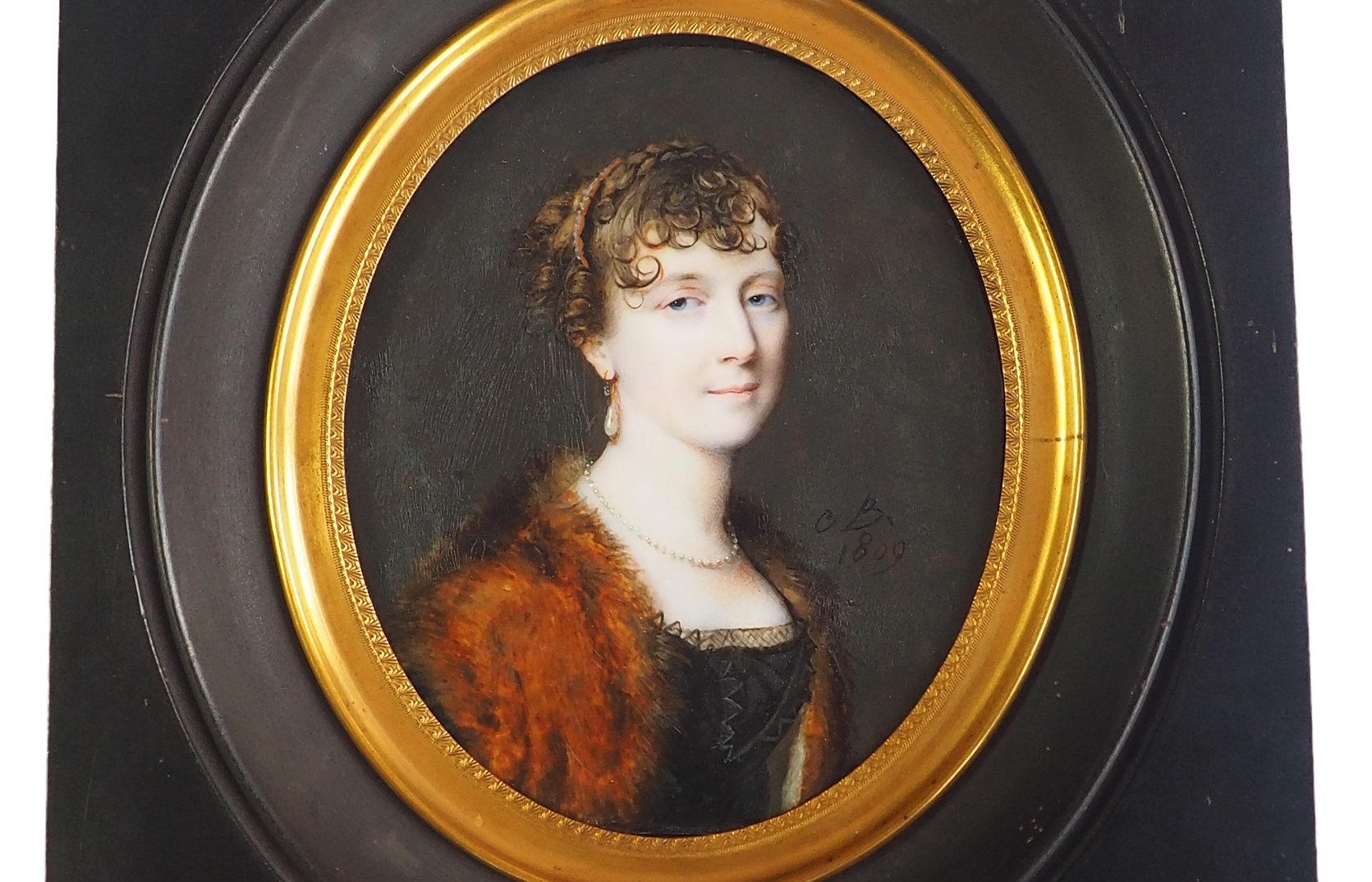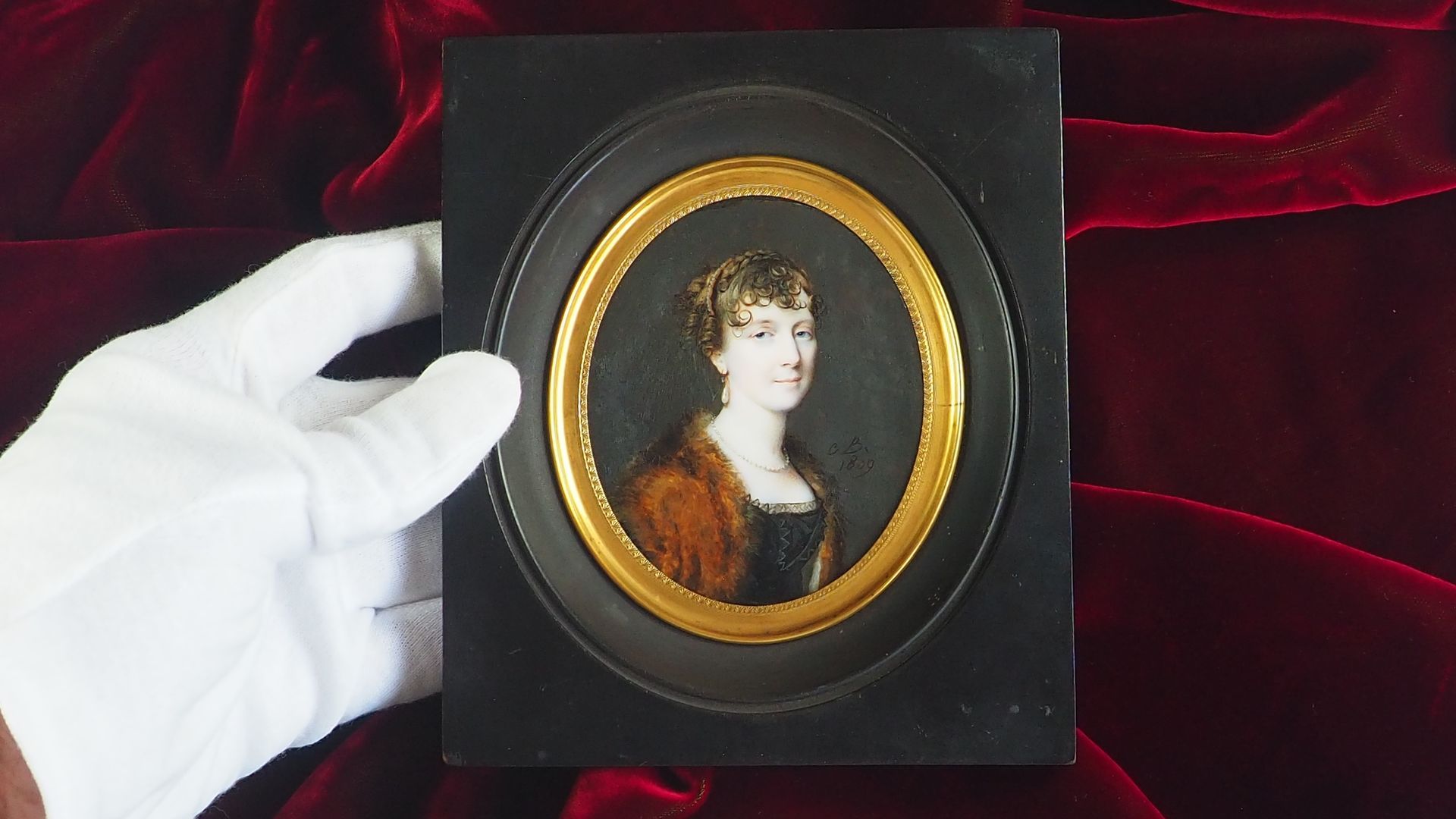BOURGEOIS CHARLES GUILLAUME ALEXANDRE
(1759-1832)
Portrait of Dorothea Katherine von Boehtlingk (1775-1857), wife of Frédéric-César de La Harpe (1754-1838)
1809
Signed on the right: CB 1809
Watercolor and gouache on ivory, oval 9 x 7.5 cm.
Original frame in gilded metal and blackened wood, 16 x 13.5 cm.
Labels on the back
Very beautiful miniature signed on the right by Charles Guillaume Alexandre Bourgeois: CB 1809
This beautiful portrait is identified on the reverse: “Dorothéa Boehtlingk / femme de G.al La Harpe / peint à Paris par Bourgeois / 1810”. It is
Dorothea Katherine von Boehtlingk (1775-1857), wife of Frédéric-César de La Harpe (1754-1838), a Swiss politician, friend, confidant and tutor of Tsar Alexander I of Russia.
De La Harpe accompanies the Russian princes to Italy for the Grand Tour. Empress Catherine entrusted this republican with the education of her grandsons Alexander and Constantin. La Harpe does not present himself as a simple teacher, but as a "guide to princes", responsible for making them enlightened men. For eleven years, he will teach Alexander liberal principles, the sense of justice, his role for the happiness of his peoples.
Dorothéa Boehtlingk is shown half-length in the composition that is typical of this painter. She is dressed in a black dress, with precious red fox fur, in a three-quarter bust, turned to the right, her gaze facing the viewer. A proud and confident Russian woman, perhaps also thanks to the protection of the Tsar.
One of the most successful miniature female portraits that the artist bequeaths to us, very well preserved in its original frame.
Professional catering. For other photographs and information on the state of conservation, please contact us.
Price: 6400 €
BIBLIOGRAPHY:
Bénézit, Schidlof, Bouchard, Blatte.
Note on the Harp family:
Andreev A. Yu., Tosato-Rigo D., Imperator Aleksandr I i Frederik-Sezar Lagarp: pisʹma, dokumenty, 1, Moscow, 2014.
Bader P.-L., Un Vaudois à la cour de Catherine II: François de Ribeaupierre (Ivan Stepanovitch) 1754– 1790, Lausanne, Genève, 1932.
Biaudet J.-C., Nicod F., éd., Correspondance de Frédéric-César de La Harpe et Alexandre Ier, suivie de la correspondance de F.-C. de La Harpe avec les membres de la famille impériale de Russie, 1–3, Neuchâtel, 1978–1980.
Kopanev N., “Ils servirent leur patrie par l’épée et la plume,” in: L. Golay, A. Karouova, eds., Suisse-Russie: des siècles d’amour et d’oubli, Berne, 2006, 17–24.
Lortholary A., Le mirage russe en France au XVIIIe siècle, Paris, 1951.
Plavinskaia N., “Catherine II et le grand duc Alexandre Pavlovitch,” in: G. Luciani, C. VolpilhacAuger, eds., Institution du prince au XVIIIe siècle, Ferney-Voltaire, 2003, 175–180.
Rey M.-P., “De Rolle à Saint-Pétersbourg, l’itinéraire d’un homme d’infl uence, F.-C. de La Harpe, précepteur et confi dent du tsar Alexan dre Ier,” in: O. Meuwly, ed., Frédéric-César de La Harpe. 1754– 1838, Lausanne, 2011, 36–47.
Rey M.-P., “La Harpe éducateur du futur Alexan dre Ier,” in: V. Rjéoutski, A. Tchoudinov, eds., Le Précepteur francophone en Europe, XVII–XIXe siècles, Paris, 2013, 259–272.
Rjéoutski V., ed., Quand le français gouvernait la Russie: L’éducation de la noblesse russe 1750–1880, Paris, 2016.
Ryzhenkov M. R., “S. La Harpe—educator of the future Emperor Alexander I of Russia. According to documents of Russian State Archive of Ancient Documents,” Herald of an Archivist, 4, 2009, 172–184. Stroev A., “Les débuts pédagogiques de FrédéricCésar de La Harpe,” in: O. Meuwly, ed., FrédéricCé sar de La Harpe. 1754–1838, Lausanne, 2011, 23–35.
Tosato-Rigo D., “‘Polʹzuiutsia reputatsiei liu dei chestnykh i poriadochnykh. . .’ Shveitsarskie guvernery i guvernantki v Rossii (1750–1850),” Rodina, 1, 2014, 30–34.
MUSEUMS :
M.A.D., Paris; M.B.A. Montréal, Louvre, Bowes Museum,Nationalmuseum Stockholm, coll. Tansey, Musée Carnavalet, Muzeum Narodowe.
Photo 5: Le Petit Château (in Plessis-Piquet, near Paris) was a beautiful 18th century residence destroyed in 1954 to widen the street and build the city of childhood. It was occupied under Napoleon I by Frédéric-César de La Harpe and Dorothea Katherine von Boehtlingk









